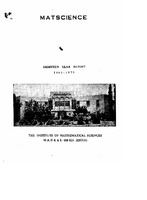- DSpace Home
- →
- IMSc Annual Reports
- →
- IMSc Annual Reports
- →
- View Item
JavaScript is disabled for your browser. Some features of this site may not work without it.
| dc.contributor.author | The Institute of Mathematical Sciences | |
| dc.date.accessioned | 2021-04-09T05:08:26Z | |
| dc.date.available | 2021-04-09T05:08:26Z | |
| dc.date.issued | 1979 | |
| dc.identifier.uri | https://dspace.imsc.res.in/xmlui/handle/123456789/541 | |
| dc.description.abstract | Eighteen years have passed since the birth of the Institute which has now attained the age of majority in Indian law. Even within two years of its inception we claimed that it had leapt from infancy to manhood, thanks to the cooperation from the International community of scientists and the dedicated work of my distinguished colleagues. This forward manhood has naturally raised high expectations in our sponsors and naturally we have to answer the obvious question — Do the achievements measure up to hopes raised and promises made? During this period the world had been dazzled, almost overpowered by scientific and technological achievements. Man has landed on the moon and viewed his planet from the lunar surface, an incredible achievement but an inevitable culmination of the systematic application of the laws of motion and gravitation discovered by Newton in the seventeenth century. Nuclear energy has been harnessed and is becoming the hope and despair of a world, intoxicated with the triumphs Of science and distracted by selfimposed conflicts among nations. Man has ushered in age of the computer which is supplementing the human brain in all his activities. Our Institute is devoted to the pursuit of excellence in mathematical sciences, anf endea'vour as significant as man’s conquest of space and his ingenious use of natural resources in the pursuit of prosperity and happiness. Mathematics is the basis of all sciences and its pursuit is happiness itself, exceeded only by a sense of achievement arising therefrom. At the dawn of the century, the great German mathematician Hilbert had formulated his famous problems that would engage the most gifted minds in mathematics for a hundred years. The solution of some of these problems is reckoned to be as significant as the discovery of electricity or the invention of the automobile and the aeroplane. In fact such fundamental discoveries have been the basis and sustenance of technological achievements. Mathematical reasoning has led to a deeper understanding of the forces of nature, the unification of which was the dream of Einstein, the father of relativity and the concept of equivalence of mass and energy which have led to the atomic age. It was given to Professor Salam at Trieste and Professors Glashow and Weinberg at Harvard, to unify two fundamental interactions-the Weak and the Electromagnetic, hitherto considered as distinct and unrelated. Professor Salam and Niels Bohr have been the progenitors of our Institute along With Nehru and Subramaniam, representing the Central and State Governments. We wish to express our. profound admiration for and gratitude to Professor Salam by having his portrait unveiled along with those of Hilbert and Newton by our esteemed Governor, an ardent supporter of Matscience. In this report we have summarised the achievements of our academic staff. Our work has been primarily confined to the domain of theoretical physics, though we have made a beginning in mathematics in Functional Analysis. We propose to strengthen our activities in mathematics by the addition of new disciplines: Analytic Number Theory and Numerical Analysis. Number theory is as old as mathematics itself but still bears a youthful countenance claiming many admirers and votaries. If mathematics is the queen of sciences, number theory is the queen of mathematics. The solution of many problems in Number Theory requires a knowledge of techniques from several areas and an ability to blend them. It was our great fortune that in December 1974 we had Professor Paul Erdos, one of the greatest mathematicians of our times, as a distinguished visitor to our Institute. It is our earnest belief that just as Professor Bohr’s visit stimulated theoretical physics, the visit of Erdos will prove to be the starting point of research in Number Theory in South India. It is a strange and inexplicable fact that in Madras, the home of Ramanujan, very little work is being done in the domain of Number Theory. Matscience has made a beginning by first organising a summer seminar in Number Theory in August last year with a senior mathematician Professor K. Ramachandra of the Tata Institute of Fundamental Research and Dr. Krishnaswami Alladi of the Department of Mathematics, Ann Arbor, Michigan, a young protege of Professors Erdos and Straus, as the principal lecturers. We also wish to initiate work in Numerical Analysis and Computational Methods, which will bring physicists and mathematicians together-something which is yet to happen in India, though everyone accepts the obvious truth that technical advance is stimulated by fundamental discoveries in science. I request our esteemed Governor to unveil the portraits to inspire the academic community at the Institute. Alladi Ramakrishnan Director | en_US |
| dc.relation.isbasedon | https://www.imsc.res.in/annrep | en_US |
| dc.rights | The Institute of Mathematical Sciences, Chennai | en_US |
| dc.subject | Annual Report | en_US |
| dc.title | 1962 - 1979 - Eighteen Year Annual Report | en_US |
| dc.publisher | The Institute of mathematical sciences - Chennai | en_US |
| dc.type | Annual Report | en_US |
